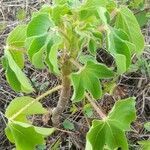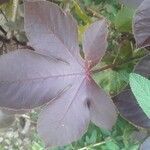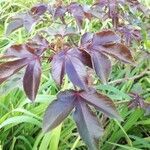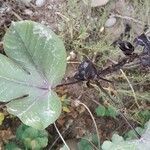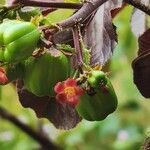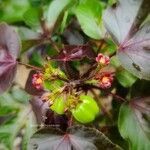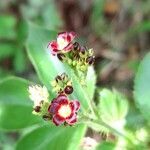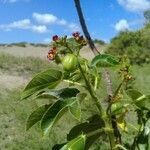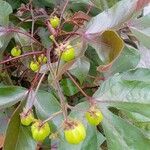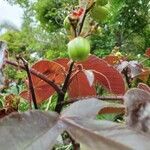Subshrub or robust herb 1-2 m high, stems softly woody; branches glabrous. Leaves with petioles cylindric, 3-6 cm long, with branched glandular setae similar to those of the stipules; stipules parted to base into 2-4 slender branched glandulif-erous setae ca 3-5 mm long; blades 3-5-lobed halfway to the base or more, 5-8 cm long, mostly 7-15 cm broad, palmatinerved, ? cordate at base, the lobes oblong or elliptic, acute or short-acuminate at the tip, closely glandular-denticulate along margins, pinnately veined. Dichasia terminal on branches, with lateral axes alternate; peduncle minutely puberulent, ca 2-4 cm long; bracts lanceolate, acumi-nate, glandular-ciliate, the lower ones 8-12 mm long. Staminate flowers with pedicels less than 2 mm long; calyx-lobes ovate-lanceolate, acuminate, with stalked capitate glands on margins, distinctly imbricate, 2-4(-5) mm long; petals obovate, dark reddish or purplish-red, ca 3-5 mm long; stamens 8, the filaments 2.2-3 mm long, connate or strongly coherent in the lower 1/3, the anthers ovate, 0.5-0.7 mm long; pistillode absent. Pistillate flowers with pedicels less than 5 mm long, puberulent; calyx-lobes similar to staminate but puberulent and becoming larger (5-7 mm long); ovary pubescent, the styles slender, ca 1.5 mm long, dilated into emarginate stigmata. Capsules subglobose, 3-sulcate, ca 1 cm in diam, glabrescent, slightly verruculose; seeds dark grayish, with small black specks, mottled grayish-and brown, or dark chestnut brown, slightly compressed, 5.5-7.3 mm long, the caruncle massive, deeply laciniate, 1.2-1.9 mm long, 2.1-3.3 mm broad.
A shrub. It grows 1.5 m tall. The leaves are divided into 3 lobes. The leaves are purplish. The flowers are in groups 10-15 cm long. The flowers are dark red. The fruit is oblong and has 2-3 lobes. It is 1.3 cm long and brown when ripe.
Shrub or small tree, up to 3 m high. Leaves palmately lobed, petioles with gland-tipped hairs along their entire length. Flowers red.
